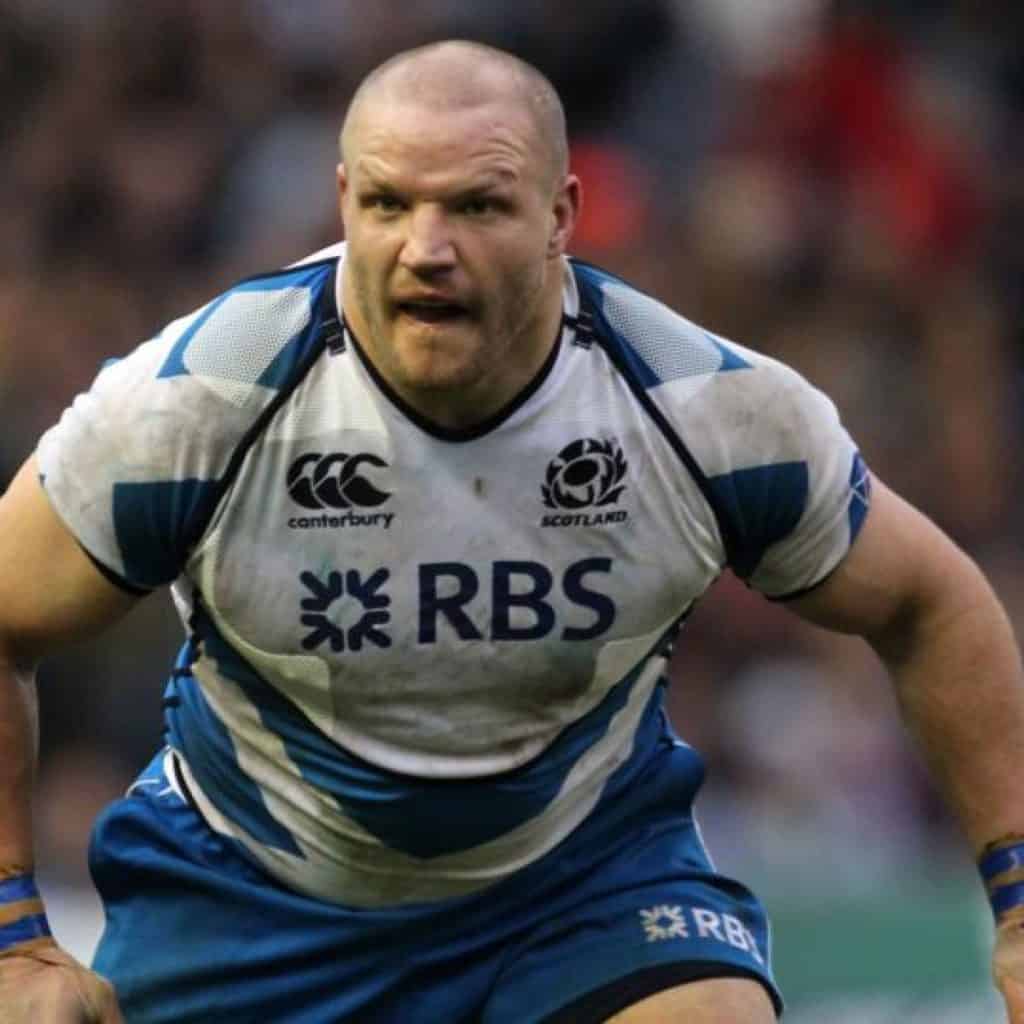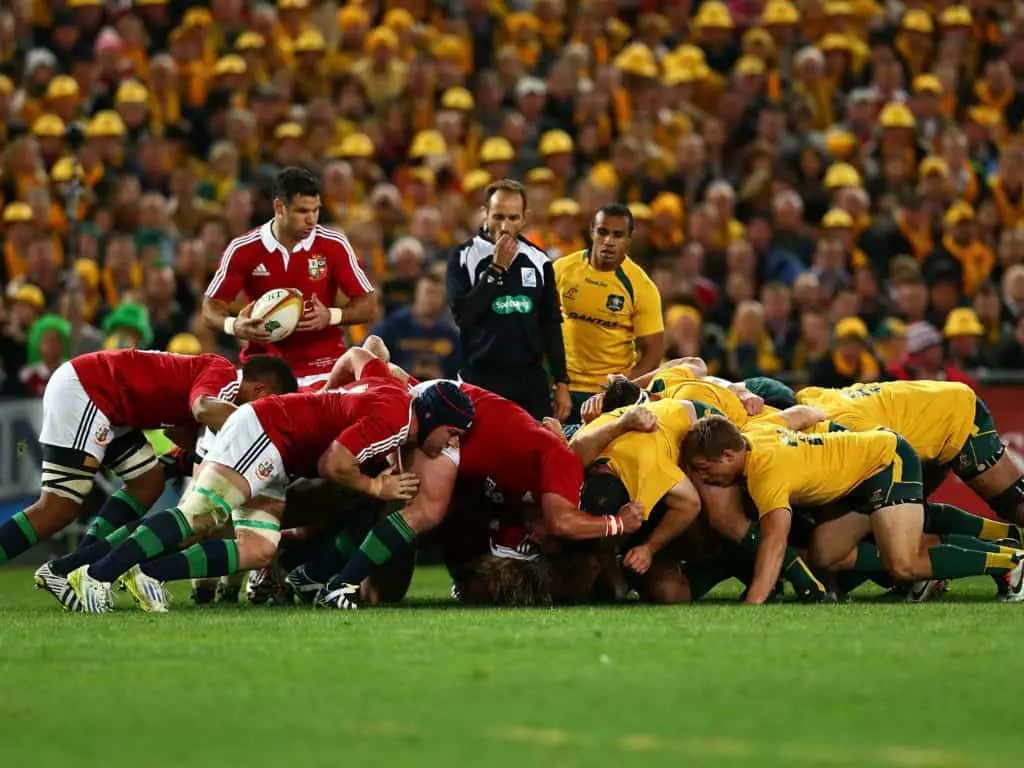If you ever stepped on the rugby pitch or watched some rugby on TV you will have noticed that there is a serious lack of pencil necks among rugby players. In this article we will explain why rugby players have such muscular necks and how you can develop your own neck so you can turn yourself into a prime Mike Tyson.
Why do rugby players have thick necks?
Rugby players have thick necks because the nature of rugby particularly tackling, rucking and scrumming causes the neck to grow. Rugby players further develop their necks by performing specialized weight training such as weighted neck harness and 4 way neck exercises.
Does Rugby Make Your Neck Bigger?

Does rugby make your neck bigger? Rugby will make your neck bigger. Performing thousands of tackles and clean outs will cause your neck to become highly defined. If you are a front row forward your neck will further develop from all the scrumming.
Rugby may not lead to you developing a neck as big as a wrestler’s but rugby is still a highly neck intensive sport which will force your neck to grow.
What Rugby Movements Cause Your Neck To Grow?
- Scrumming – During a scrum a huge amount of force will be transferred through your neck, it takes incredible amounts neck strength to maintain a straight neck the initial contact and then throughout the pushing, your neck will be forced to grow to handle the stress of scrumming
- Tackling – A good tackle not only uses your shoulder, arms and legs but the neck also plays a big role, when you are finishing a tackle you should be looking up and driving with your neck to give your tackles extra power and ensure your opposition is driven back, this driving motion with your neck causes your muscles to grow, if you are tackling correctly it won’t be along until you need some new shirts
- Cleaning Out – Just like tackling a good clean out requires you to maintain a good straight neck and to also use it as a battery ram to drive your opposition back, your neck will blow up after performing clean out over and over again
- Mauling – Similar to a scrum during a maul there is a tremendous amount of pressure placed on the neck, to keep your neck straight and to keep driving forward requires a bull like neck, your neck will either develop to handle the nature of mauling or you will get injured, I hope it’s the former
Is Rugby Bad For Your Neck?

Is rugby bad for your neck? Yes, rugby can be bad for your neck. Neck injuries are common in rugby with many players experiencing herniated discs and nerve damage. Serious neck injuries leading to permanent damage such as paralysis do occasionally occur typically when players are trapped under body weight in compromising positions but are fortunately rare.
The neck experiences a high amount of stress during rugby. You are using your head to tackle, clean out and can also end up taking blows to your neck from head clashes or being driven into the ground. It is common in rugby to get trapped in positions where your neck is bent and you are carrying the body weight of multiple people. These nasty situations can result in neck injuries.
The most common neck injury in rugby is a cervical sprain. A Cervical sprain is a soft tissue injury which usually occurs due to excessive movement past its natural range of motion. Fortunately, they are usually minor but they can still cause some serious pain and stiffness. Front row forwards are most susceptible to these injuries as they mostly occur during scrumming and mauling.
How Common Are Neck Injuries In Rugby?
Neck injuries are uncommon in rugby with 2.9 injuries occuring every 1000 exposure hours. Of the injuries that do occur 69% are minor, 17% mild, 7% moderate and 7% serious. Cervical strain was the most common form of neck injury in rugby.
How Do Neck Injuries Occur In Rugby?

The most common way neck injuries occur in rugby is during scrums, accounting for 58% of injuries. During scrums necks can be hyperextended as they give in to the extreme pressure being placed on them. This is why front row forwards are most likely to suffer neck injuries.
64% of scrum related neck injuries occurred during the initial contact and 36% occurred when the scrum collapsed. 78% of the injured players were hookers and 19% were props. Hookers are clearly most susceptible to neck injuries during scrums.
Another common cause of neck injuries during rugby is awkward falls from tackles where players land on their head which can result in sprains or even breaks. Rugby players can also hurt their necks when they are trapped at the bottom of rucks or mauls and their necks bent under the pressure of a pile of bodies.
How Do I Avoid Neck Injuries In Rugby?
- Warm up – get your neck warm, stretch, move your neck through the full range of motion, practice contact – tackling, scrumming, cleaning out
- Maintain Strong Posture – neck and back straight, core engaged, looking slightly up, spine stacked on top of each other in straight line, never let your neck become bent, if you are having trouble keeping your neck straight bend your legs more and drop your centre of gravity
- Train Your Neck – perform specific neck strengthening exercises such as rolling bridge to increase your strength
How Do I Strengthen My Neck For Rugby?

How do I strengthen my neck for rugby? To strengthen your neck for rugby you need to train the specific rugby movements which strain your neck (tackling, scrumming, mauling). The more rugby you do the more your body will adapt. You can also do weighted neck exercises such as 4 way neck exercise and using a weighted harness. You can also add wrestling to your regime.
What Are Some Good Neck Exercises For Rugby?
Here are some great exercises which will transform your pencil neck and turn you into a scrumming god:
- 4 way neck exercise – very simple just hop on a bench and pick up a weight plate, get on your stomach on the bench with your head off the bench, place weight plate on the back of your head, bring your chin to your chest and extend until your neck is straight, lie on your back and both sides and repeat the process until you have done all 4 angles, start off light and perform 30 reps each side, increase the weight once you can perform 40 reps with good form
- Weighted neck harness – you can buy a harness which you place on your head and can attach weights to, to strengthen your neck move your neck up and down and back and forth, start off light, the neck is a sensitive area, so it is best to perform high repetitions with low weight vs low reps with high weight
- Rolling bridge – this is similar to the wrestler’s bridge but a safer alternative, the wrestler’s bridge is a famous neck exercise however it can wear out your discs, this will give you all the benefits without the side effects, get in the plank position, put weight on your forehead and roll without letting your shoulders or arse touch the ground until you are back in the starting position, perform 30 reps, focus on moving slowly and keeping your neck straight
Here Is How To Perform A Rolling Neck Bridge:
- Deadlift – deadlifts don’t just cause your back and legs to blow up, they also will build your neck, start off performing 4 sets of 6 reps with the goal to increase the load every workout, start off light and add 2.5kg per training session
Conclusion
Rugby players have thick necks because all that tackling, mauling, cleaning out and scrumming tires out the neck muscles forcing them to adapt and grow. Rugby players also build their necks in the weight room by using a weighted neck harness and performing other movements such as 4 way neck exercise. Neck injuries are fairly uncommon but do occur with scrums being the major cause and cervical sprains being the most common injury. If you want to avoid neck injuries from rugby you need to maintain a strong posture (core engaged, neck and back straight) and train your neck regularly.
